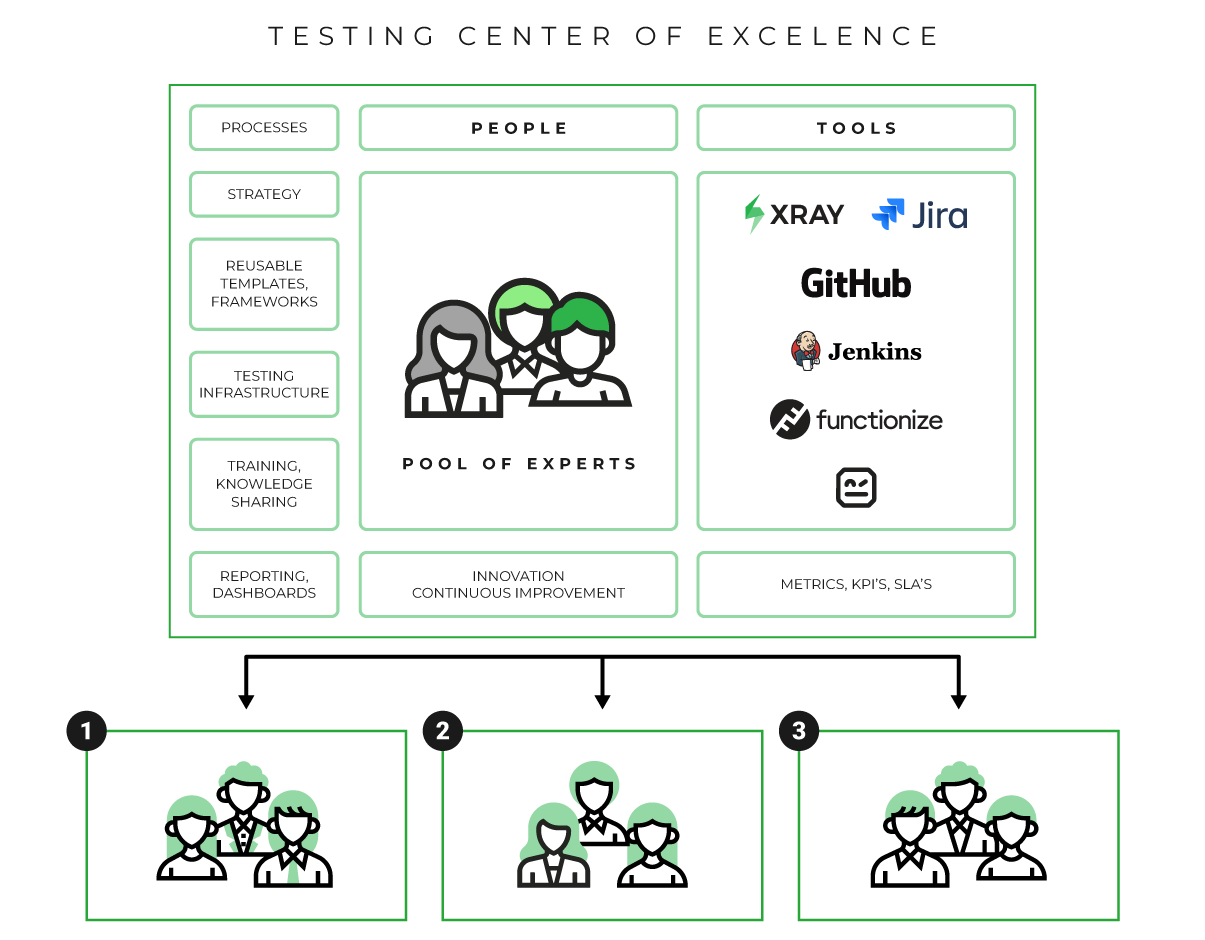Innovation takes a back seat when testers are busy with day-to-day tasks like writing test cases and reporting bugs. A Testing Center of Excellence (TCoE) is the hub of innovation. This team of experts, researches and adopts the latest trends, technologies, and tools to maximize the value of software testing across an organization. The TCoE constantly focuses on improving and standardizing testing and quality processes to provide a competitive edge for the organization.
In this article, we’ll show you everything you need to know about the Testing Center of Excellence (TCoE) and the benefits of implementing it in your organization.
Why the need for a Testing Center of Excellence (TCoE)?
In most organizations, testers are spread across several teams and report to their respective managers; with this approach, testers do not share a common goal or direction. Unfortunatley, the individual efforts of these separate testing teams often fail to make an impact because of the fragmented approach. Testing differs from a team to team basis, making it difficult to standardize the testing process and practices across the organization.
Standalone teams generally lack standard testing processes, sharing proven practices, tools, etc. Siloed testers may track different KPIs/metrics, while some may not measure anything. A decentralized structure may limit cross-team visibility and knowledge sharing. When testing teams are siloed, this leads to a waste of time and effort as testers keep reinventing the wheel each time.
To overcome these challenges, organizations can adopt a centralized model of software testing called the Testing Center of Excellence (TCoE).
What is a Testing Center of Excellence?
A Testing Center of Excellence (TCoE) is a framework where testing is a centralized service that supports the entire organization. This model consists of testing specialists, standardized testing processes, metrics, tools, and infrastructure to achieve the highest standards of excellence in the testing functions. In a TCoE, testers are shared resources across teams. The testing processes, tools, KPIs, infrastructure, and governance are centralized.
- TCoE leverages the power of centralization and standardization to achieve excellence in software testing.
- TCoE focuses on innovation, standardizing processes, implementing exemplary practices, and powerful tools with the help of highly skilled testers.
This diagram shows what a TCoE consists of and how it contributes to the testing teams.

Next, let's see the benefits that organizations experience from implementing a TCoE.
The benefits of implementing a Testing Center of Excellence (TCoE)
-
Reduces costs and increases efficiency
The TCoE establishes and promotes quality practices; that's because it provides teams with a set of standards that can be used across the organization. TCoE develops and maintains reusable documentation templates and automation frameworks that add tremendous value to the testing teams. They also provide repeatable processes, practices, and methodologies that avoid common pitfalls.
Standardization is the key to increasing efficiency. For instance, establishing a common automation framework for test automation reduces the learning curve and time to script. Standardizing test case design, test planning, test data manager, tooling, etc., and reduces waste and increases efficiency.
When organizations achieve maturity in testing practices, they can better respond to business challenges resulting in more efficient test cycles. Additionally, the TCoE ensures optional utilization of testing resources (people, processes, tools, infrastructure, budget, etc.).
2. Fosters innovation and keeps your testing team ready for the future
For many organizations, the TCoE acts as the hub of innovation and quality. TCoE offers guidance and leadership to the testing teams across an organization. The TCoE researches and stays on top of the latest trends in the industry so that they can choose the best approaches and train teams on the new technologies, techniques, processes, and tools that they choose to adopt.
Additionally, TCoE owns the hiring and onboarding of testers with diverse skills based on the organization's testing needs. Effective hiring, onboarding, and training will create a strong team of testers.
3. Creates alignment between business and testing teams
The testing goals are often aligned to project goals rather than the larger organizational goals. TCoE consolidates all testing functions under one umbrella so that testers can focus on the shared organizational goals. TCoE establishes a governance model and reporting structure for the standalone teams.
Furthermore, TCoE defines and measures standard testing KPIs aligned with the business expectations ensuring tighter alignment. These KPIs provide a big picture of quality to the business and allow them to measure the ROI in the TCoE.
Pitfalls to avoid
Implemeneting a new way of working presents its own set of challenges. What should organizations keep in mind before intoducing a TCoE?
-
Limiting innovation only to the TCoE
The Testing Center of Excellence should work on standardization while still providing each team a reasonable level of freedom. Innovation and experimentation should be encouraged outside by TCoE as well.
-
Avoid bureaucracy
The centralized structure of TCoE may lead to bureaucracy. Decision-making and authority should not solely depend on TCoE. Define how much control the TCoE holds. Empower testers and leaders to contribute to decision-making.
-
Not getting executive buy-in
Getting executive buy-in is a critical part of any successful initiative. Pitch the idea of TCoE to your executives. Demonstrate how implementing TCoE can help achieve organizational goals backed by data. Start small with minimal investment without disrupting the existing teams. Scale-up when you start seeing results.
What is a modern Testing Center of Excellence?
The traditional TCoE in the pre-agile era acted as the nucleus for all testing activities for an organization. After the coding phase, the TCoE tested the build and provided feedback after performing different tests. However, this traditional model of TCoE's incurred delays in software delivery.
Today, more and more organizations are shifting towards Agile and DevOps (decentralization) to deliver business agility. Modern TCoEs have evolved and complement contemporary development frameworks and methodologies like Agile and DevOps.
To get the best of both worlds, organizations maximize the value derived from centralization (TCoE) and decentralization (Agile/DevOps).
In a modern TCoE, testers work closely with developers within cross-functional teams but still report up to managers of the TCoE to ensure appropriate alignment and governance. The TCoE fully backs the testers for all their testing and automation needs. The TCoE shares expertise, including test automation, performance testing, security testing, test data management, and leadership in a centralized service. They act as the research and development centers for software testing.
The TCoE delivers practices, tools, frameworks, KPIs, training guides, reusable assets/templates, etc. TCoE can carry out strategic decisions with a more significant impact beyond the team's scope, and the individual teams can make additional tactical decisions specific to the project.
Can a TCoE work for your organization?
The answer is for you to determine. To reach higher QA maturity levels, find the right balance between centralization and decentralization. Transitioning into TCoE is a journey; depending on your goals, it can reduce redundancies and streamline testing processes when done correctly.
Implementing a TCoE sets you up to achieve operational excellence in software testing. Furthermore, it can help you improve your team's efficiency while reducing costs. Finally, and perhaps most importantly, it can foster a culture of quality within your organization.


